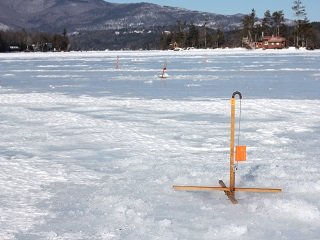 With ice fishing right around the corner—and starting in some regions of the country—there will be many new ice anglers on the frozen lakes this season. If you’ve ever spent some serious time on the ice, then you know that tip-ups are invaluable when it comes to filling your cooler with fish. Not everyone is familiar with these little helpers, though, which is why today I’ve provided you with some tips for your own tip-up use this winter.
With ice fishing right around the corner—and starting in some regions of the country—there will be many new ice anglers on the frozen lakes this season. If you’ve ever spent some serious time on the ice, then you know that tip-ups are invaluable when it comes to filling your cooler with fish. Not everyone is familiar with these little helpers, though, which is why today I’ve provided you with some tips for your own tip-up use this winter.
As with most outdoor activities, your success on the ice can weigh heavily upon your pre-fishing research. This means taking the time to study maps of your planned waters to find potential honey holes and create a game plan for when you get there.
Be sure to drill your holes and set your tip-up in the right spots. You don’t want to be too close or too far from structure that may be holding fish. Seek out potential ambush locations like green weeds, breaks, river currents, bottom transitions, and other structure where baitfish may be hiding. Be sure to steer clear of dead weeds, though, as fish are drawn to vegetation that produces oxygen, not rotten greenery.
When you lay your tip-ups, make a conscious effort to keep from setting them too closely together. Try to fish different locations along any given area of structure, spreading them out as far as state regulations allow. If it helps, try to imagine the ice as a grid and position your tip-ups out from your base location at varying depths.
As far as hook and line size is concerned, knowing what size to use for a given species is important. Here, I’d load the spool with 30-pound tip-up line and tie 8 to 10 feet of 8 lb fluorocarbon to a swivel. However, if in doubt go a size smaller. For example, you can use a #16 treble hook for walleye, which will get the job done without the bulk of a larger hook. For pike, though, you’ll want to switch out the 8 lb fluorocarbon for 12 lb and move up to a #12 treble hook.
The tips outlined above will help your experience with tip-ups get started on the right foot this season. Keep an eye out for more tip-up tips as you prepare for a great season on the ice!








